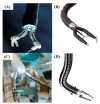Frontiers of Robotic Gastroscopy: A Comprehensive Review of Robotic Gastroscopes and Technologies
- PMID: 32998213
- PMCID: PMC7600666
- DOI: 10.3390/cancers12102775
Frontiers of Robotic Gastroscopy: A Comprehensive Review of Robotic Gastroscopes and Technologies
Abstract
Upper gastrointestinal (UGI) tract pathology is common worldwide. With recent advancements in robotics, innovative diagnostic and treatment devices have been developed and several translational attempts made. This review paper aims to provide a highly pictorial critical review of robotic gastroscopes, so that clinicians and researchers can obtain a swift and comprehensive overview of key technologies and challenges. Therefore, the paper presents robotic gastroscopes, either commercial or at a progressed technology readiness level. Among them, we show tethered and wireless gastroscopes, as well as devices aimed for UGI surgery. The technological features of these instruments, as well as their clinical adoption and performance, are described and compared. Although the existing endoscopic devices have thus far provided substantial improvements in the effectiveness of diagnosis and treatment, there are certain aspects that represent unwavering predicaments of the current gastroenterology practice. A detailed list includes difficulties and risks, such as transmission of communicable diseases (e.g., COVID-19) due to the doctor-patient proximity, unchanged learning curves, variable detection rates, procedure-related adverse events, endoscopists' and nurses' burnouts, limited human and/or material resources, and patients' preferences to choose non-invasive options that further interfere with the successful implementation and adoption of routine screening. The combination of robotics and artificial intelligence, as well as remote telehealth endoscopy services, are also discussed, as viable solutions to improve existing platforms for diagnosis and treatment are emerging.
Keywords: artificial intelligence; gastric cancer; gastroscopy; machine learning; robotic gastroscopy.
Conflict of interest statement
A.K. and J.N.P. disclose travel support from Jinshan Science & Technology (Group) Co., Ltd. The other co-authors declare no conflict of interest.
Figures




Similar articles
-
Frontiers of Robotic Colonoscopy: A Comprehensive Review of Robotic Colonoscopes and Technologies.J Clin Med. 2020 May 31;9(6):1648. doi: 10.3390/jcm9061648. J Clin Med. 2020. PMID: 32486374 Free PMC article. Review.
-
Deep learning for gastroscopic images: computer-aided techniques for clinicians.Biomed Eng Online. 2022 Feb 11;21(1):12. doi: 10.1186/s12938-022-00979-8. Biomed Eng Online. 2022. PMID: 35148764 Free PMC article. Review.
-
Microrobotics for future gastrointestinal endoscopy.Minim Invasive Ther Allied Technol. 2007;16(2):91-100. doi: 10.1080/13645700701266982. Minim Invasive Ther Allied Technol. 2007. PMID: 17474052 Review.
-
Application of robotic technologies in lower gastrointestinal tract endoscopy: A systematic review.World J Gastrointest Endosc. 2021 Dec 16;13(12):673-697. doi: 10.4253/wjge.v13.i12.673. World J Gastrointest Endosc. 2021. PMID: 35070028 Free PMC article.
-
Frontiers of robotic endoscopic capsules: a review.J Microbio Robot. 2016;11(1):1-18. doi: 10.1007/s12213-016-0087-x. Epub 2016 May 2. J Microbio Robot. 2016. PMID: 29082124 Free PMC article. Review.
Cited by
-
Gastric Cancer Screening Methods: A Comparative Study of the Chinese New Gastric Cancer Screening Score and Kyoto Classification of Gastritis.Gastroenterol Res Pract. 2022 Mar 9;2022:7639968. doi: 10.1155/2022/7639968. eCollection 2022. Gastroenterol Res Pract. 2022. PMID: 35309108 Free PMC article.
-
Actuation and design innovations in earthworm-inspired soft robots: A review.Front Bioeng Biotechnol. 2023 Feb 21;11:1088105. doi: 10.3389/fbioe.2023.1088105. eCollection 2023. Front Bioeng Biotechnol. 2023. PMID: 36896011 Free PMC article. Review.
-
Comparison of Magnifying Endoscopy with Blue Light Imaging and Narrow Band Imaging for Determining the Invasion Depth of Superficial Esophageal Squamous Cell Carcinoma by the Japanese Esophageal Society's Intrapapillary Capillary Loop Classification.Diagnostics (Basel). 2021 Oct 20;11(11):1941. doi: 10.3390/diagnostics11111941. Diagnostics (Basel). 2021. PMID: 34829288 Free PMC article.
-
A Novel Biopsy Capsule Robot Based on High-Speed Cutting Tissue.Cyborg Bionic Syst. 2022 Aug 5;2022:9783517. doi: 10.34133/2022/9783517. eCollection 2022. Cyborg Bionic Syst. 2022. PMID: 39081833 Free PMC article.
-
A variable stiffness manipulator with multifunctional channels for endoscopic submucosal dissection.Int J Comput Assist Radiol Surg. 2023 Oct;18(10):1795-1810. doi: 10.1007/s11548-023-02875-5. Epub 2023 Apr 1. Int J Comput Assist Radiol Surg. 2023. PMID: 37002467
References
-
- Etemadi A., Safiri S., Sepanlou S.G., Ikuta K., Bisignano C., Shakeri R., Amani M., Fitzmaurice C., Nixon M.R., Abbasi N., et al. The global, regional, and national burden of stomach cancer in 195 countries, 1990–2017: A systematic analysis for the Global Burden of Disease study 2017. Lancet Gastroenterol. Hepatol. 2020;5:42–54. doi: 10.1016/S2468-1253(19)30328-0. - DOI - PMC - PubMed
Publication types
LinkOut - more resources
Full Text Sources

